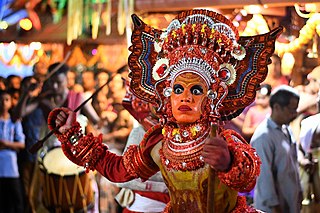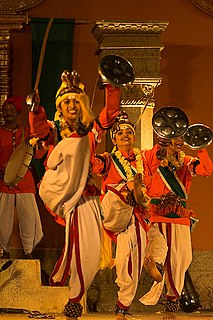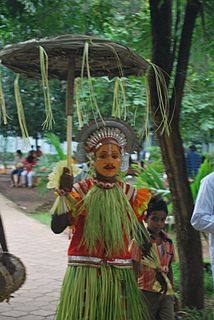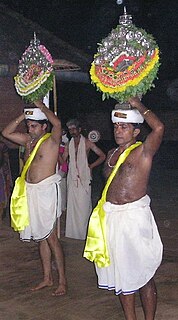
Theyyam is a popular ritual form of dance worship in Kerala and Karnataka, India. Theyyam consisted of several thousand-year-old traditions, rituals and customs. The performers of Theyyam belong to the lower caste community in ancient caste structure formed by Namboothiri brahmins in Kerala, and have an important position in Theyyam. The people of these districts consider Theyyam itself as a channel to a God and they thus seek blessings from Theyyam. It is performed by mainly by males, except the Devakoothu theyyam. The Devakoothu is the only Theyyam ritual performed by women.It is performed only on the Thekkumbad Kulom temple.

The janggu or sometimes called seyogo is the most representative drum in traditional Korean music. It is available in most kinds, and consists of an hourglass-shaped body with two heads made from animal skin. The two heads produce sounds of different pitch and timbre, which when played together are believed to represent the harmonious joining of Um and Yang. Janggu [장구] is one of instruments of Samulnori [사물놀이]. Samulnori consists of Janggu, Buk [북], Jing [징] and kkwaenggwari [꽹과리]

The Jangam or Jangama are a Shaiva order of religious monks. They are the priests or gurus of the Hindu Shaiva sect. Jangamas are also gurus of Veershaiva' sect. Jangamas are disciples of Lord Shiva as mentioned in Basava Puranas. A visit of a jangam to a house is treated as the visit of Lord Shiva himself and the jangam shall be given good alms and the jangam blesses the natives. The Jangam is the wandering holy man in Virashaivism. The meaning of word Jangam is 'moving linga' and considered superioir to 'sthira linga'.

Golu is the festive display of dolls and figurines in South India during the autumn festive season, particularly around the multiday Navaratri festival of Hinduism. These displays are typically thematic, narrating a legend from a Hindu text to court life, weddings, everyday scenes, miniature kitchen utensils, anything a little girl would have played with. They are also known as Kolu, Gombe Habba, Bommai Kolu or Bommala Koluvu.

Karnataka has a variety of traditional arts, including folk dance and puppetry.

Channapatna toys are a particular form of wooden toys that are manufactured in the town of Channapatna in the Ramanagara district of Karnataka state, India. This traditional craft is protected as a geographical indication (GI) under the World Trade Organization, administered by the Government of Karnataka. As a result of the popularity of these toys, Channapatna is known as Gombegala Ooru (toy-town) of Karnataka. Traditionally, the work involved lacquering the wood of the Wrightia tinctoria tree, colloquially called Aale mara (ivory-wood).

Togalu gombeyaata is a puppet show unique to the state of Karnataka, India. Togalu gombeyaata translates to "a play of leather dolls" in the native language of Kannada. It is a form of shadow puppetry. Karnataka Chitrakala Parishat has undertaken research on this art and has a good collection of leather puppets.

Veeragase is a dance form prevalent in the state of Karnataka, India. It is a vigorous dance based on Hindu mythology and involves very intense energy-sapping dance movements performed by Jangama. Veeragase is one of the dances demonstrated in the Dasara procession held in Mysore. This dance is performed during festivals and mainly in the Hindu months of Shravana and Karthika. It is performed at all important functions of Lingayat household.
Tamil Nadu has a rich history of art and entertainment. The three modes of entertainment classified as Iyal (Literature), Isai (Music) and Nadagam (Drama) had their roots in the rural folk theatre like Theru Koothu. Many forms of group and individual dances with the classical forms for popularity and sheer entertainment value. Some of the dance forms are performed by Tribal people. The majority of these dances are still thriving in Tamil Nadu today.

Aati Kalenja is an ancient traditional folk art form practiced by Tulu people from the region of Tulu Nadu, India which is believed to bring prosperity during Aati which is one of the months in Tulu calendar. It normally comes in the months of July and August.

Kummattikali or Kummatti Kali is the famous colorful mask-dance of Kerala, prevalent in Thrissur District, Palakkad District and parts of South Malabar. During the festival of Onam, Kummattikali performers move from house to house collecting small gifts and entertaining people. Kummatti dances are rampant in the Thrissur district during Onam. Pristine or original form of Kummattikali can be seen in the Bhadrakali temple in Palakkad district. Kerala

Navaratri is a Hindu festival that spans nine nights and is celebrated every year in the autumn. It is observed for different reasons and celebrated differently in various parts of the Indian cultural sphere. Theoretically, there are four seasonal Navaratri. However, in practice, it is the post-monsoon autumn festival called Sharada Navaratri that is the most observed in the honor of the divine feminine Devi (Durga). The festival is celebrated in the bright half of the Hindu calendar month Ashvin, which typically falls in the Gregorian months of September and October.

Thidambu Nritham is a Hindu ritual dance performed in Temples of North Malabar in India. It is mainly performed by Namboothiris, and rarely other Brahmin communities like Shivalli, Karhade and Havyaka.

The term 'hobby horse' is used, principally by folklorists, to refer to the costumed characters that feature in some traditional seasonal customs, processions and similar observances around the world. They are particularly associated with May Day celebrations, mummers' plays and the Morris dance in England.

The taal, manjira, jalra, or gini is a pair of clash cymbals, originating in the Indian subcontinent, which make high-pitched percussion sounds. In its simplest form, it consists of a pair of small hand cymbals. The word taal comes from the Sanskrit word Tālà, which literally means a clap. It is a part of Indian music and culture, used in various traditional customs e.g. Bihu music, Harinaam etc.It is a type of Ghana vadya.
Dhumpa sangita is a folk musical art form from the Ganjam and Nayagarh districts of Odisha in India. It derives its name from the dhumpa, a bamboo percussion instrument that accompanies the performance. The tradition is currently on the decline and faces the threat of extinction.

Jaanapada Loka, is a folk museum that has an exclusive display of the village folk arts of Karnataka. It is under the aegis of the Karnataka Janapada Parishat. Loka Mahal, a wing in the museum has a display of 5,000 folk artifacts. It is situated in Ramanagara, Ramanagara district in the Indian state of Karnataka, on the Bangalore-Mysore highway, 53 kilometres (33 mi) to the south of Bangalore.

Bedara Vesha is a folk dance performed days before Holi night in Sirsi town of Karnataka. It is also known as ‘Hunter Dance’. People of Sirsi celebrate Holi with this unique folk dance every alternate year. It attracts a large crowd from different parts of the state on all the five days of Holi.

The Indian state, West Bengal has a rich cultural heritage. Due to the reign of many different rulers in the past, arts and crafts in West Bengal underwent many changes giving an artistic diversity today in the forms of traditional handicrafts, terracotta, painting and carving, dance, music except of natural beauty and glorious past the state has the strong hold of art and architecture which made the state so unique.

















